#Loading Dock Design Service
Explore tagged Tumblr posts
Text
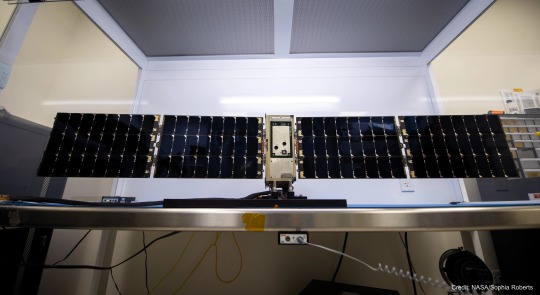
Tiny BurstCube's Tremendous Travelogue
Meet BurstCube! This shoebox-sized satellite is designed to study the most powerful explosions in the cosmos, called gamma-ray bursts. It detects gamma rays, the highest-energy form of light.
BurstCube may be small, but it had a huge journey to get to space.
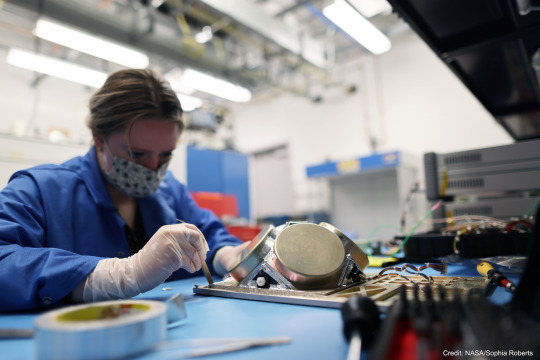
First, BurstCube was designed and built at NASA’s Goddard Space Flight Center in Greenbelt, Maryland. Here you can see Julie Cox, an early career engineer, working on BurstCube’s gamma-ray detecting instrument in the Small Satellite Lab at Goddard.
BurstCube is a type of spacecraft called a CubeSat. These tiny missions give early career engineers and scientists the chance to learn about mission development — as well as do cool science!
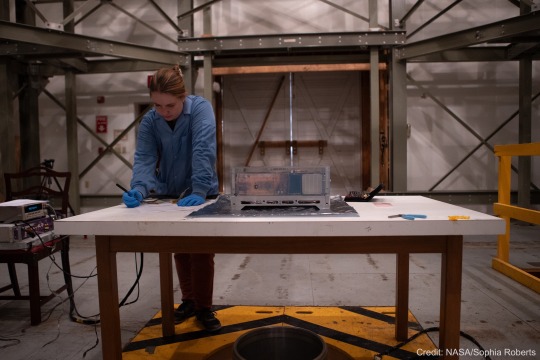
Then, after assembling the spacecraft, the BurstCube team took it on the road to conduct a bunch of tests to determine how it will operate in space. Here you can see another early career engineer, Kate Gasaway, working on BurstCube at NASA’s Wallops Flight Facility in Virginia.
She and other members of the team used a special facility there to map BurstCube’s magnetic field. This will help them know where the instrument is pointing when it’s in space.
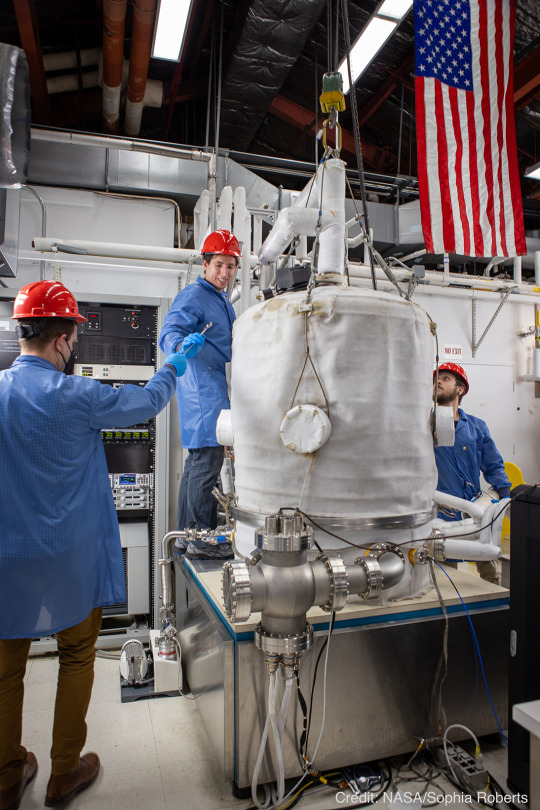
The next stop was back at Goddard, where the team put BurstCube in a vacuum chamber. You can see engineers Franklin Robinson, Elliot Schwartz, and Colton Cohill lowering the lid here. They changed the temperature inside so it was very hot and then very cold. This mimics the conditions BurstCube will experience in space as it orbits in and out of sunlight.
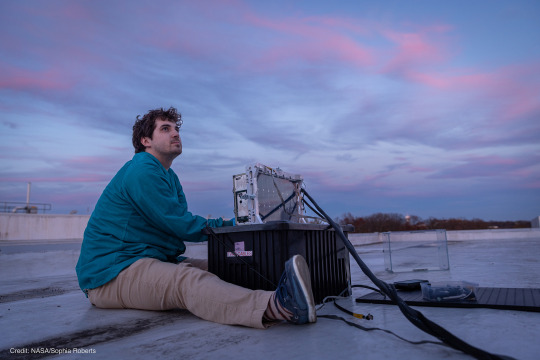
Then, up on a Goddard rooftop, the team — including early career engineer Justin Clavette — tested BurstCube’s GPS. This so-called open-sky test helps ensure the team can locate the satellite once it’s in orbit.
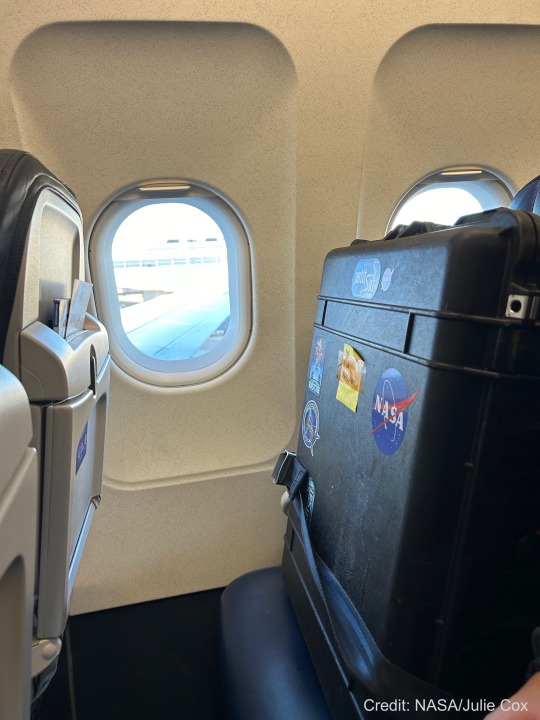
The next big step in BurstCube’s journey was a flight to Houston! The team packed it up in a special case and took it to the airport. Of course, BurstCube got the window seat!

Once in Texas, the BurstCube team joined their partners at Nanoracks (part of Voyager Space) to get their tiny spacecraft ready for launch. They loaded the satellite into a rectangular frame called a deployer, along with another small satellite called SNoOPI (Signals of Opportunity P-band Investigation). The deployer is used to push spacecraft into orbit from the International Space Station.

From Houston, BurstCube traveled to Cape Canaveral Space Force Station in Florida, where it launched on SpaceX’s 30th commercial resupply servicing mission on March 21, 2024. BurstCube traveled to the station along with some other small satellites, science experiments, as well as a supply of fresh fruit and coffee for the astronauts.
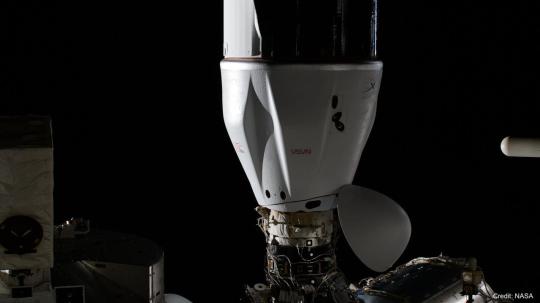
A few days later, the mission docked at the space station, and the astronauts aboard began unloading all the supplies, including BurstCube!

And finally, on April 18, 2024, BurstCube was released into orbit. The team will spend a month getting the satellite ready to search the skies for gamma-ray bursts. Then finally, after a long journey, this tiny satellite can embark on its big mission!

BurstCube wouldn’t be the spacecraft it is today without the input of many early career engineers and scientists. Are you interested in learning more about how you can participate in a mission like this one? There are opportunities for students in middle and high school as well as college!
Keep up on BurstCube’s journey with NASA Universe on X and Facebook. And make sure to follow us on Tumblr for your regular dose of space!
#tech#technology#dream job#jobseekers#NASA#space#spaceblr#universe#astronomy#science#gamma ray bursts#cubesat#smallsat#launch
657 notes
·
View notes
Text
Disney Dreamland - Part 4: Fantasyland
(I had already posted about Mysteryland previously, which retroactively makes it Part 3. So we're moving on to the next part.)
Quite possibly the largest of the five lands, probably even beating out my mega-Adventureland.

Small World Gardens
Located behind Small World, this sprawling area would transition into Storybook Town Square. Flower arrangements inspired by Keukenhof in the Netherlands. Similar to Paris’s Fantasyland, there would be a couple rivers running through the garden with lovely bridges to cross over them.
Dumbo the Flying Elephant : The Masquerade Circus could be positioned near the Mysteryland/Fantasyland border so that the back of the tents could serve as a backdrop for the Dumbo ride, which would have its own little area in the gardens. I was at a loss on where else to place this ride, but I stubbornly wanted to include it as it is currently the only attraction to be found in all 6 existing castle parks and I didn't want to break that streak.
"Casey Jr. Circus Train": Doesn't have to specifically be Dumbo-themed, I just really want a cute novelty train to wind through the garden, with cute bridges to pass over the walkways and rivers.
“Swan Boats”: Paddle boats. I say “swan boats” but they don’t have to be just swans, but could also resemble other birds such as ducks, geese, and flamingos.
Symphony Gazebo: A gazebo in the garden for a live band to play classical music.
“Windmill snack stand”: I saw a picture of the Old Mill in Paris and thought it looked so charming. German pretzels.

Storybook Town Square
The town follows in the footsteps of Ananheim’s 1983 overhaul with each building having its own unique look. Would feature a fluid mix of Bavarian and British architecture. The Bavarian half of the town on the west contains “Pinocchio Square” and the theater. The British half on the east contains Peter Pan, Little Nemo (even though Nemo is American), and Mr. Toad. A large fountain stands in the center. Cobblestones would pave the ground. I want this area to evoke the feeling of Paris’s Fantasyland as well as Efteling in the Netherlands .
Pinocchio’s Daring Escape: Focuses more on escaping Pleasure Island. The only other thing I would change is have all the sets and animatronics appear to be carved out of wood, and have real clothes on the animatronics, for a more high-quality “hand made” look, the implication being the entire ride is a life-sized puppet show. The ride building along with the toy shop and restaurant form a smaller “Pinocchio Square”, which would include a smaller fountain with a statue of Pinocchio.
Geppetto’s Toy Shop: Would feature regular retail plush toys, as well as old fashioned toys like wooden marionettes and wind-ups, as well as cuckoo clocks. Christmas ornaments can also be purchased here.
Pinocchio’s Pizza Place: Italian cuisine. Basically the Pinocchio Village Haus in Orlando, but with an alliterative name, and also some of the pizzas have toppings decorated to look like Pinocchio smiley faces. Quick service.
Once Upon a Time Theatre: Hosts live indoor stage shows. While any show with Disney musical medleys is fine, I would much prefer original shows of rarely-featured stories, such as the other tales from the 1001 Arabian Nights, or a stage version of Disney's Return to Oz (which I personally love better as an Oz adaptation than MGM's movie; 2013's Oz the Great and Powerful was meh). Building design would be modeled after the new Fantasyland Forest Theatre in Tokyo.
“German restaurant”: Table service.
Flight to Neverland: Would utilize the best aspects from each version of the ride. For example, I love that Shanghai’s queue is themed to a London park (Kensington Gardens?), and the chimneys in Paris’s loading dock blow smoke. The building facade would definitely have a functioning clock tower, in homage to Big Ben, but designed to fit with the small town aesthetic. The name change is simply because I feel like guests actually take on the role of the Darling children more than they do Peter.
Little Nemo in Slumberland: Little Nemo may not be a Disney IP, but it has such rich and vibrant imagery, I think it could work really well as a Disney ride. Not to mention it’s in the public domain, so there shouldn’t be any legal issues. In many ways it’s very similar to Peter Pan’s Flight, so maybe it could also help balance the wait times between the two rides. Guests take on the role of Nemo and ride flying beds (or at least, benches that look like beds, with a headboard and a footboard) that soar out the bedroom window. What follows are awe-inspiring, almost surreal, scenes of Slumberland. Things start to distort and become chaotic as the dream turns into a nightmare. Before anything too awful happens, guests “wake up” back in Nemo’s bedroom while the voice of Nemo’s mother scolds us for eating before bed. For visual reference, I recommend the Osamu Dezaki pilot film that was created during the movie’s development, though I obviously wouldn’t put the giant Sauron eye in the ride.
Mr. Toad’s Wild Ride: Orlando’s former double-track ride, but with Anaheim’s building exterior. I never got to experience this ride and I really want to.
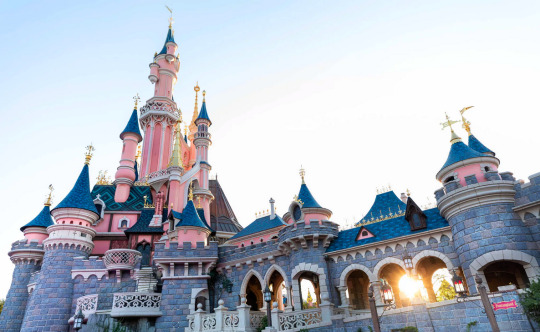
Ever After Castle
Here it is, the traditional centerpiece of all Disney parks, now the centerpiece of Fantasyland instead. I personally think of most Disney castles as tall but not wide. This castle would be slightly different from the traditional Disney castle by taking up more ground space. I hate to sound blasphemous, but for this castle I’m thinking of something similar to Shrek’s Far Far Away Castle in Universal Singapore but with more detailed ornate decorations like Paris’ castle, and the outer walls slightly covered in ivy vines for a more inviting, homely look. It would also stand on top of an elevated foundation, surrounded by a moat. There would be a large courtyard in front of the main castle building, with the carousel placed in the center of it. The gift shop and the meet-and-greet are each placed on either the west or east side of the courtyard. The north of the courtyard would feature the restaurant on the ground floor, the entrance to the underground boat ride, and stairs to the second floor attraction.
Cinderella’s Carriage Carrousel: Regarding the visual design, I want it to look like the pumpkin carriage turned into a carousel. The canopy could include fiber optic fairy dust that lights up at night.
Be Our Guest Restaurant: French cuisine. I really like Tokyo’s Beauty and the Beast ride and would love to import it, but I respect the OLC’s exclusivity rights too much. I wondered if I could make it a combination ride and restaurant where each table is a ride vehicle, but I worried that would cause motion sickness which is a big no-no for a restaurant. At the very least, for my version I would love to have animatronics perform “Be Our Guest” every 30 minutes or so. Also, perhaps every hour, Belle and Beast performers would come out onto the dance floor and invite guests to waltz with them. Hot Take: The Grey Stuff is very obviously a savory food as it is clearly presented on a tray of hors d'oeuvres in the movie. But since the version currently offered in the parks has been imprinted in fans’ minds I think it’s best to offer two versions: Savory (chicken liver pate) as an appetizer and Sweet (cookies and cream) as a dessert.
Royal Meet-and-Greet: I personally do not care much for meet and greets, but for the people that do, here you can meet the Princesses, some of the Princes, as well as non-Princesses such as Giselle, Esmeralda, and TinkerBell.
Kingdom Treasures gift shop: Based on the Tokyo shop of the same name.
Crystal Caverns Canal: Boat ride underneath the castle. My first idea for this ride was basically Voyage to the Crystal Grotto from Shanghai, if all the character statues were built out of crystals and mosaic tiles. Then I realized, there’s probably too much IP already in the land, so I think there could be an original story about the crystals being a source of magic for the kingdom, and have scenes of wizards and fairies harvesting the crystals and creating experiments with them. Sort of a “tour of the workshop” kind of ride. I’m thinking of something with the same vibes as Dreamflight in Efteling.
Merlin’s Library / Yen Sid’s Library: Located on the second floor of the castle. Originally I wanted a ride in a similar vein to Symbolica in Efteling, but with a story like that of Mystic Manor in Hong Kong. Then I wondered if it would be feasible to have a ride in the second story, so I’m also okay with this being a walkthrough attraction. I feel either wizard could work here. Merlin is the more well-known wizard, but Yen Sid is easier to create an original backstory for. The basic gist of the attraction is you wander around a library with little vignettes of magical items operating on their own; a quill pen writing by itself, a large spell book turning its own pages, floating books sorting themselves on the shelves, etc. There could even be some interactive elements, such as paintings that change, or opening a book can project a scene “coming to life” and “escaping” the book.
Fairytale Gardens: Walkthrough garden. There would be lovely little vignettes scattered throughout, including Snow White’s wishing well, a giant beanstalk, and The Sword in the Stone placed in a little alcove in the castle’s outer wall. This would be outside the courtyard. Maybe off to the side, to the west, wrapping around the outer castle wall, next to Shadowland Forest.

Shadowland Forest
Inspired by the Black Forest of Germany, this area features spookier attractions. West of the castle, shares the border with Mysteryland and the Gravity Falls area. There would be plenty of fir, spruce, and pine trees to make it feel like an actual forest, maybe even hide some of the attractions from view.
Snow White’s Scary Adventures : Building facade would include the Evil Queen peeking out her window. I would place the building nearest to Storybook Town Square, at the edge of the forest.
“Gingerbread Factory Tour” : Based on my twisted Hansel and Gretel dark ride idea. Guests are given a tour of gingerbread golems at work (something like Tim Burton’s version of Wonka’s factory if it were more surreal and set in 1800s Germany), then are chased through obstacles, such as lollipop blades swinging from the walls, and peppermint stick darts, by Hansel and Gretel themselves. They’ve been very distrustful of adults after their parents abandoned them in the woods, and after the witch held them captive. They deem the guests harmless, and let them go but warn them to never come back.
Candy Carnival shop: The ride would exit into a shop themed to a candy carnival safe haven that Hansel and Gretel built for children lost in the woods. Would feature gingerbread treats and a nice selection of old-fashioned candies and German sweets. Guests can also watch bakers and candymakers at work. (Despite the name, there are no actual rides here, just animatronic decorations.)
Dragon Mountain: I wanted a unique “Mountain” ride, much like how the Matterhorn and Everest are unique to their parks. And dragons are cool. Originally this was going to be based on Maleficent, but now I’m leaning more towards an original story. And to put a neat spin on things, instead of a fire-breathing dragon, it would be a wintery ice dragon! I would also love it if the dragon was not portrayed as a mindless, violent beast hoarding treasure, but a parent protecting their child from intruders.
I initially wanted a sub-land recreating Halloween Town (with a spooky "Scare-ousel") but I felt Fantasyland was already overrun with too many IPs (and seven carousels is enough for one park), so here an area is set aside for seasonal Nightmare Before Christmas or Villains themed events, leaving the Haunted Mansion free during the holidays.
Disney Dreamland Railroad Fantasyland station: Styled after the ruins of a medieval castle. Located on the edge of the forest near Ever After Castle, next to the entrance to Winter Village.
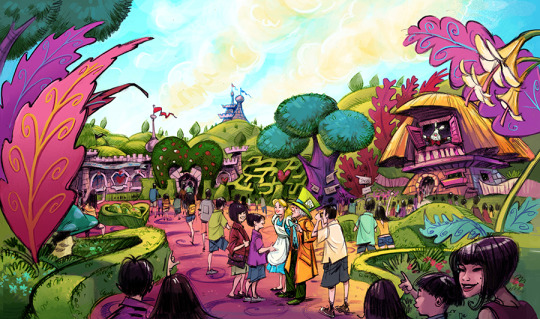
Wonderland
East of the castle, on the border with Create-It-Land. While there would be plenty of natural green, there would also be an abundant mix of giant pink, purple, and turquoise “wildlife”, as seen in the initial scrapped concept art for Tokyo’s expansion. Giant mushrooms in place of benches, trees decorated with misleading signs, lamp posts that look like giant flowers. March Hare would definitely be included as a walk-around character alongside Hatter and Alice. People often forget the tea party took place at the Hare’s and mistakenly believe Hatter to be the host, and I will not stand for this March Hare erasure. I would also have plenty of card soldiers roaming around, “patrolling” the area.
Down the Rabbit-Hole: An upside-down funhouse with wonky mirrors, and trick doors galore! A hall of doors in the end would lead into the maze. I was thinking there could probably also be a madhouse ride portion where guests can experience the room actually turning upside down; inspired by Villa Volta in Efteling.
Wonderland Maze: As much as I like the Alice in Wonderland ride in Anaheim, I personally feel that Wonderland is a world that is best experienced up close and at your own pace, which a maze perfectly embodies. While the maze would obviously be themed to classic animated Alice like the Paris version, it would have different environments, like Shanghai’s Tim Burton version. First half of the maze would be a forest-like environment with giant plants and singing flowers. Second half would have rose bushes, fancy iron fences, and carved stone walls and statues for the Queen of Heart’s castle area. There would be a handful of tiny doors scattered throughout that guests can crawl through as shortcuts. Among the character statues scattered around the maze, I really want to include the Mock-Turtle and Gryphon, based on their designs from the Jell-O commercial, perhaps on a sandy beach shore by a small fountain / pond.
House of Cards Banquet Hall: Inspired by the Queen of Hearts Banquet Hall in Tokyo. Would follow the same eccentric and colorful design scheme, but I want it to look like a stone castle made out of cards. Definitely would have lovely stained glass windows. Desserts include Royal Heart Tarts. They could also come in souvenir cups and plates like the ones found in Tokyo.
Mad Tea Party: Would have a canopy roof to protect from the weather and direct sunlight, but I also wouldn’t mind a stained-glass version. Or even a canopy made of trees. Teacup designs would be a mix of various patterns from all versions (except Orlando’s, I do not care for the zigzag scribbles). Would also include the giant teapot with the Dormouse in the center. To help with queue waits, I’d even have two ride systems, much like how Orlando doubled their Dumbo ride. One could even be themed to the Hatter while the other to the March Hare.
March Hare’s tea shop: Would have the same building design as March Hare Refreshments in Paris. Would sell several varieties of tea, Unbirthday Cake, and macarons. Could also feature a long table with interactive tea things to play with, like Shanghai does at the end of its maze, and plenty of fancy chairs for photo-ops.
Mad Hatter’s hat shop: Hats, Mickey ears, and other headgear. To match the March Hare’s chimney ears, this building would resemble a large top hat. Would also feature hat racks for photo-ops, like Shanghai does at the end of its maze.
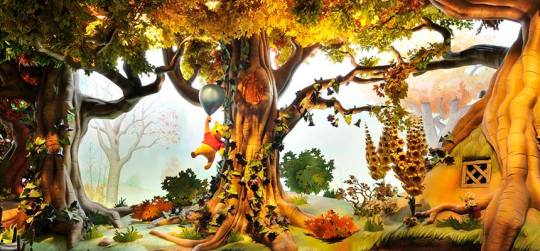
100 Acre Wood
East of Town Square, on the border with Create-It-Land. A tiny little area with tall trees providing shade, a lovely little Poohsticks Bridge over a small river, and a cozy corner for a meet-and-greet with Pooh and friends.
Winnie the Pooh and the Blustery Day: Basically the same as Pooh’s Hunny Hunt in Tokyo, which includes the giant book facade, and the same level of crafted detail and technical marvel throughout the ride, but with scenes added for the “rain, rain, rain”, and Pooh’s hero party as the ending. I would also use Anaheim’s zany color scheme for the Heffalumps and Woozles room with some added special effects for even more zaniness. The ride’s name change is just to both set it apart from the other versions, and because I realized with the exception of Pooh stuck in the honey tree, all the iconic scenes in the ride come from Blustery Day.
Pooh Corner gift shop: Also utilizes the same English cottage look as Tokyo’s.
Hunny Smackerels snack stand: Hunny Pot cupcakes, honeycomb, honey ice cream, and a separate cart for honey popcorn in lovely Pooh-shaped popcorn buckets. It would be really cute if the stand is actually inside a giant tree trunk, with a dutch door counter window for guests to order from.
The next three sub-lands would be behind Ever After Castle, outside the perimeter of the railroad tracks border. The entrance to Winter Village is between Shadowland Forest and the castle, while the entrance to Encanto Valley is between Wonderland and the castle. Mermaid Lagoon is directly behind the castle, between the other two sub-lands and only accessible through them. Small mountains would form berms for each sub-land. For reference, think of how Grizzly Gulch, Mystic Point, and Toy Story Land are arranged in Hong Kong.
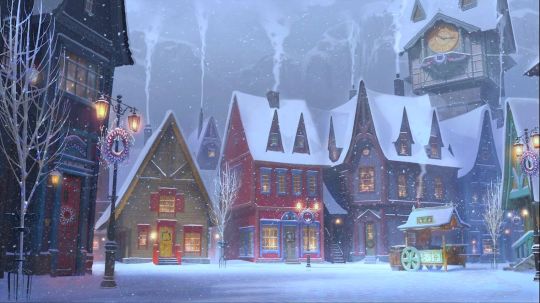
Winter Village
Inspired by my Narnia theme park concept. This entire mini-land would be indoors, to have air-conditioning to sell the illusion of winter, and to preserve the artificial winter setup from the real-life elements outdoors. This mini-land would be round (roughly) so that the glass ceiling that lets in natural light can have a hexagonal snowflake design. At night time there’d be projections of Northern Lights. NOT Frozen themed. It’s a cute movie and all, but far overstayed its welcome before it was even released on DVD. Village would be a mix of Russian and Scandinavian architecture. Can be used for a Santa Claus meet-and-greet during Christmas.
Enchanted Snow Palace: The planned but never built ride based on Hans Christian Andersen’s Snow Queen. The concept art looks leagues better than the final product of Frozen Ever After.
“Winter Sleigh Ride”: Ride through winter scenery in sleighs pulled by reindeer. Technically a dark ride, since the entire subland is indoors, but feels like an outdoor ride.
"Snowball Arcade": I really wanted something to simulate snowball fights, but without the chaos and mess. Here, guests can throw snowballs at targets to win plush prizes.
"Russian cafe": Russian pastries and snacks
"Ice skating rink": Free if you bring your own skates.

Mermaid Lagoon
A scaled-down version of the land in Tokyo DisneySea, without the playground and kiddie rides. Like DisneySea, it would have a lovely seashell castle facade, with the attractions indoors. Unlike DisneySea, there would be a small lake in front with a ship restaurant docked on it.
“Under the Sea”: NOT a retelling of the movie, but instead an original story that would take place some time pre-movie. Follows Ariel on one of her outings as she explores the sea looking for new treasures to add to her collection. Final scene could be of Ariel in her grotto after completing her latest trip, but feeling unsatisfied as she wistfully looks at her collection, while instrumentals for “Part Of Your World” softly play in the background.
King Triton’s Concert Hall: Just like the one in Tokyo DisneySea, this would be a 360 degree show with Ariel “swimming” in midair above the audience, a giant animatronic Triton, performer puppets of Flounder and Sebastian, and other mixed special effects.
Undersea Carousel: Fish carousel. Underwater lighting effects and blows bubbles as it spins.
Ariel’s Grotto gift shop
Ship restaurant: Mediterranean seafood. I mean, it’s on a human ship that’s not technically in Triton’s Kingdom, so I think this gets a pass for serving fish. It could even be themed to Chef Louis for a laugh.
“Nighttime Water Show”: Just spitballing an idea, maybe the lagoon could also be used for a nighttime water show a la Fantasmic / World of Color. The viewing area could be across the lagoon from Triton’s castle; the lights of Triton’s castle would coordinate with the show.

Encanto Valley
A lovely recreation of the valley, with Casita and a little village area for shops and Colombian dining, and plenty of lush greenery.
La Casa Madrigal: I really like @rrdcooc’s idea for Casita as a walkthrough attraction! It’s so cool! Especially the ideas for Pepa and Luisa's rooms. I wouldn’t change much, aside from adding a few extra touches, such as an interactive flower wall in Isabela’s room that mimics guests’ silhouettes (like Daniel Rozin's "Mechanical Mirrors"), and maybe a couple themed flat rides to add capacity, such as a flowery swing spinner ride in Isabela’s room, and a tiny jungle animal carousel in Antonio’s room. In Dolores's room, guests can see sound waves (like that Magic School Bus episode), and Camilo's room can contain "mirrors" with different character models that mimic guests' movements in real time (like VTuber avatars). Also includes a gift shop selling “homemade” fashions and plush toys by Mirabel.
“Magic Realism Art Exhibit”: While I think the final movie is perfect, I would have loved it if Casita more closely resembled its concept art, which leaned much more heavily into magic realism. This attraction would be a walkthrough art exhibit full of giant optical illusion paintings that guests can pose in for photo-ops. For reference, I’m recalling the Trick Eye Museum, a temporary art exhibit I went to years ago in Hong Kong.
Encanto Sing-Along: I’m not always a huge fan of the “book report” shows they do in the Parks, but in this case, most of Encanto’s songs are so specific to the story that removing them from the context of the movie wouldn't work (especially in the case of fan favorite “We Don’t Talk About Bruno”). The stage can also be used for original Colombian performances, as well as from neighboring Latin American countries.
Julieta’s Arepas: Food cart. These arepas may not heal you, but they’re magically delicious!
Arabian Oasis (scrapped)
Before Encanto was released and became one of my favorite recent movies, my initial idea was to put in an Aladdin-themed area. Not an exact recreation of Agrabah, more like a broad strokes version of Agrabah in the same manner as Arabian Coast in Tokyo DisneySea.
Magic Carpet Ride: A suspension ride in a similar manner as Peter Pan’s Flight, using the carpet vehicles. Fly through the Agrabah marketplace, over the desert, and above the clouds. Ride music features instrumentals from “A Whole New World”.
Scheherazade’s Tales From the 1001 Nights: Stage show.
Flavors of Agrabah: Arabian / Middle-Eastern cuisine
Cave of Wonders gift shop: I think the theming is appropriate considering guests are exchanging money for goods and not stealing them (ideally).
Other parts:
World Galleria
Adventureland
Mysteryland
Create-It-Land
Discoveryland
#disney parks#disney dreamland#armchair imagineering#fantasyland#alice in wonderland#winnie the pooh#little mermaid#encanto#theme park design
15 notes
·
View notes
Note
I saw you photo of the ship you sail in response to Lucy Bellwood’s sail anatomy and would love to hear more about it! I’ve never seen a square rigger with … is that a tiny crane for loading? So cool!
What's this? An excuse to talk about The Best Barque In The World, SV Tenacious? Well, I don't mind if I do!

First, yes, that is a tiny crane. She actually has two of them, for launching the two RHIBs.
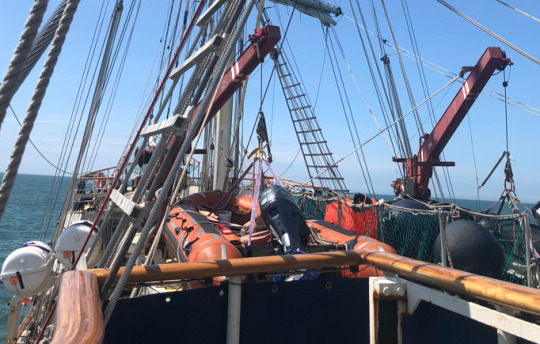
She also has a more traditional derrick, essentially a human-powered crane, which is used for loading heavy stuff and setting up the gangways.
Tenacious is far from being a traditional ship. She was launched in 2000, and is the only tall ship currently operating* that was designed specifically to be sailed by a disabled crew.
This means:
wheelchair lifts throughout the ship
decks wide enough for wheelchairs**
a talking compass, so people with visual impairments can't avoid taking their turn on the wheel!
power assisted steering and a joystick for people with limited dexterity
wheelchair clamps by the wheel, and seating for those who can't stand for long periods. (And for those who just don't want to, when there's a perfectly comfortable chair right there!)
rigging for a harness to allow people with limited mobility to get into the RHIBs
ascender systems that allow wheelchair users to take themselves up the masts. (Here's a photo of someone doing just that last week.)

On the more mundane side, there are showers with seats, handrails and adjustable showerheads. There are two or three clos-o-mat toilets, and the majority of the toilets are wheelchair-accessible. There are bunks which have anchor points for wheelchairs, and lifts to get in and out of the bunk.
More than that, however, is the ethos of the ship. There are no passengers on Tenacious. Everybody is part of the crew. Everybody stands their watch (and if I could get out of the morning watch, 4am-8am, I absolutely would). Everybody does their mess duty. Everybody takes part in happy hour (cleaning the ship - both the romantic stuff of the scrubbing the deck and the less so of scrubbing the toilets).
Everybody is assigned a buddy when they join the ship. If you're disabled, this is the person you turn to when you need a bit of extra help. (I have CFS. On my first voyage, I pushed myself so hard, because I wanted to get the absolute most out of the experience, that I ended up curled up on my bunk and sobbing because I was too tired to go and eat dinner. My buddy went and spoke to the cook and brought me a meal in my bunk.)
However, if your buddy isn't around, you can ask absolutely anybody, and they'll do it without making a big deal of it.
The Tenacious ethos is that everybody has something to offer, and everybody sometimes needs help. It doesn't matter whether you're disabled, currently able-bodied, or just completely unable to remember which bit of string to pull. You'll never be shouted at, and you'll never be made to feel a burden.
If my hard sell has worked and you want to sail on Tenacious - guess what? YOU CAN!
She's owned and operated by the Jubilee Sailing Trust and you can book a voyage on their website. There are bursaries available to help with cost.
*JST used to operate two tall ships. Unfortunately, COVID and financial issues meant the STS Lord Nelson was taken out of service, and is currently sitting semi-derelict in a Welsh dock, hoping for a buyer.
**Unfortunately, she can only take manual wheelchairs. Powered chairs are largely too heavy and too bulky, and also class as a fire risk. (Batteries and a lot of water aren't generally a good combination.)
14 notes
·
View notes
Text
Alisa Developer's Cut Review (Switch eShop)


Captured on Nintendo Change (Docked)Among the finest retro-style video games are nearly indistinguishable from the actual deal; video games that might have been buried in a time capsule within the ‘80s or ‘90s, lengthy forgotten earlier than being unearthed, fully intact, within the modern-day. It’s robust to tug off, although we will say with absolute confidence that Alisa Developer’s Minimize is among the most authentic-feeling homages to traditional survival horror that we’ve ever performed. We must always preface this overview by clarifying that in the event you’re somebody who hasn’t skilled ‘retro’ survival horror — with pre-rendered backgrounds, mounted digicam angles, and tank controls — then quite a lot of what makes Alisa so fantastic may not resonate with you. For many who grew up with the likes of Resident Evil and Alone within the Darkish, nevertheless, buckle up, as a result of this is the way it’s completed, of us.

Captured on Nintendo Change (Docked) Happening within the Nineteen Twenties, you play as Alisa, an ‘Elite Royal Agent’ in pursuit of a wished legal. After chasing him right into a dense forest, Alisa is attacked by unknown creatures, blacks out, and awakens in a big, foreboding mansion wearing an odd, doll-like gown with nothing however a easy pistol to defend herself. Naturally, your job is to flee, however shock shock, the mansion is chock filled with creepy enemies and perplexing puzzles. Briefly, it’s Survival Horror 101, and it’s good. Alisa takes various cues from Resident Evil, together with the creepy setting, the tank controls, the save room music, and even a barely offputting service provider who takes the type of a speaking hand puppet. With that mentioned, nevertheless, it nonetheless manages to carve its personal id effortlessly; one that does not draw back from the sheer absurdity of its premise. Dolls, clowns, and ghosts take the place of RE's zombies and BOWs (bio-organic weapons), and whereas this makes for an expertise that isn’t all the time outright scary, it's usually unbearably unsettling.

Captured on Nintendo Change (Handheld/Undocked) A variety of the stress comes from the enemies themselves, who've been designed to look as creepy as potential with out making use of gore or gross-out results. Primary doll adversaries will slowly shamble towards you, arms outstretched, whereas different creatures may use clown bikes to mow you down. There’s a heap of selection right here, however our favorite enemy must be a ghost-like doll that escapes from its glass confinement early within the sport. This Girl in Black-inspired spectre, very like the Nemesis from Resident Evil 3, will pop up randomly whenever you enter sure rooms, and if it catches you, it would deal an absolute boatload of harm. It’s a superb job, then, that the sport equips you with loads of weaponry and perks to assist guarantee your survival and hold the varied nasties at bay. You begin with a easy pistol at your aspect, and whereas the survival horror style usually encourages you to keep away from fights, taking out your enemies in Alisa rewards you with a foreign money referred to as ‘Toothwheels’, and you'll spend these with the service provider to unlock new weapons and melee weapons, similar to a blunderbuss or katana — and saving your sport additionally prices one Toothwheel. You’re additionally not caught together with your preliminary outfit, both, as new clothes will develop into obtainable periodically, granting buffs that ought to provide you with an edge when going up in opposition to extra fearsome enemies.

Captured on Nintendo Change (Handheld/Undocked) It’s not simply creepy monsters you’ll be contending with. Alisa Developer’s Minimize is crammed filled with attention-grabbing puzzles that really feel proper at house given its style. You’ll be finding distinctive keys, accumulating gadgets, transferring blocks round, fixing tile puzzles, and extra. Many of those are completely different levels of been there, completed that, however as with the whole lot else in Alisa, the puzzles in some way do sufficient to really feel comparatively contemporary. Additionally they strike a pleasant stability with their issue, offering sufficient of a problem to really feel satisfying with out straying into frustration. The place Alisa actually shines, nevertheless, is in its presentation. Certain, by trendy requirements, we will’t precisely say that it appears to be like 'good', however then that’s not the purpose. This was designed to appear to be a PS1 sport from the mid- to late-'90s, and in that respect, Alisa is a convincing success. The pre-rendered backgrounds, from the creepy village featured within the prologue to the colorful, unsettling circus space, are all well-designed and showcased fantastically with cautious placement of the digicam. Granted, there have been a few events throughout robust enemy encounters the place the digicam would flip between varied mounted angles a little bit too continuously for our liking, however for essentially the most half, their positions have been nicely chosen to successfully amplify the sensation of isolation and dread.

The identical degree of care has additionally been utilized to the music and voicework. The latter will sound amateurish to gamers not conversant in traditional survival horror video games, and whereas there’s nothing right here that may fairly match as much as a few of Resident Evil’s most memorable quotes, Alisa does an awesome job at replicating the corny voiceover work from the '90s. The music, in the meantime, ranges from quietly unnerving to panic-inducing, whereas the save room theme particularly will carry a welcoming sense of calm and security, because it ought to. All in all, you are most likely round 5-7 hours of playtime for the standard run, and that is in the event you do not trouble with the extra goodies like unlockable weapons or clothes. If you wish to choose up the whole lot, then the sport will simply push previous the 10-hour mark. Like all nice survival horrors, there's additionally ample alternative right here to flex your speedrunning abilities, with added extras like a number of endings and an non-compulsory New Sport+ mode injecting a pleasant contact of replayability.
Conclusion
Alisa Developer's Minimize is a superb homage to traditional survival horror that may simply stand toe-to-toe with the likes of Resident Evil and Alone within the Darkish. From the tank controls to the tacky voiceover work, it nails nearly each side, offering an expertise that feels prefer it was ripped straight from the '90s. Its general attraction will doubtless be restricted to those that are intimately conversant in survival horror, but when that is you, then strap your self in for the most effective examples of the style to this point. Source link Read the full article
2 notes
·
View notes
Text
Cold med dreams are fucking wild.
Imagine a chinese costco but very very different. You'd create an account and pay them money and buy a pair of HUD goggles Your money would be converted into points. Hard to say what the exchange rate is because it fluxuates so much. Once you have the points in your account then you go to the physical store. It's all chinese and asian imports. You park your car at a designated garage, walk into the store and log on. Most of the items in the store are just photos with chinese writing and a numerical point value. As you look at them with the goggles it translates it, telling you what the item is and you can select to purchaee it by tapping a button on your goggles. Therr are still many physical items in the store so you need a cart. There are rest stations with a full service coffee/tea/drink bar and a chocolate fountain. First floor is all canned goods and sweets. Second floor is all fresh seafood, world's largest display. If you buy it they will bundle or or kill it if its alive and clean it if you wish then take it down to the dock on your account. There are also other meats on this level. Level three is all fresh vegetables and fruit. Level four is sundries like shampoo, batteries, vibrators, entertainment, clothes and so on. Bulk goods such as rice are right before the dock but they're all photographs. At the dock they look at what you ordered and assemble it for you then a couple workers follow you out to your car and help load your goods.
The system though never lets you use all your points, you have a limit on how many you can use per day and it forces you to buy new points or delete your account when you fall close to 100.
Also, you have to be grandfathered in by someone. You can't just start shopping. You have to know someone who can sire you into the program. Once you're in you can sire others and you get 1000 points per person. Is that a lot? You don't know because the point values fluxuate day to day.
Welcome to Chinese Pyramid Scheme Costco Hell
10 notes
·
View notes
Text
The Vampyr Combine are the backbone of Lemuria, building and maintaining the Lemurian Merchant Aerial, and ensuring a steady supply of goods onto and off of the island. Founded and headed by Vampyr, the Combine was intended to progress Vampyric culture in a modern world, instead of stagnating with a veneration of a forgotten past.
The Combine is a loose confederation of several disparate Lemurian factions, and their respective cultures and traditions have blended into a chaotic, functional mix. Gremlins, Goblins, Vampyr, Fae, and human alike live and work together for mutual gain and defense.
The Privateers may run the Docks, the Assembly the Shipyards, and the Goblins repurpose defunct airships into useable parts in the Scrapyard, but the Merchant Aerial of the Vampyr Combine runs the Ports, bringing materials for the Assembly, materiel for the Privateers, and providing a steady business to the Scrapyards.
Their ships are not flashy, fast, or powerful, but when it comes to rugged dependability and long-term functionality, Combine Merchant Aerials simply cannot be beaten. If a thing can be found by coin or cutpurse, the Combine will find a way to get it. The markets, both Black and Legitimate, have unmatched selections and prices.
The Port District rises sharply up from the pastoral landscape of Lemuria. Massive landing platforms squat atop massive vertical warehouses. Massive Merchant Aerials plow through the local airspace to their joint docking/repair slips atop these incredible feats of engineering. Smaller warehouses can generally handle either one massive Aerial, or up to four smaller ones. The largest can handle up to five mammoth Aerials, or up to forty smaller Aerials.
The massive Towers are arranged in several long, straight rows along broad avenues dedicated solely for the smaller, local air and ground travel, with Commercial Districts popping up in the alleys between towers, perpendicular to the Port Avenues.
Atop the Towers, Combine techs work, live, and breathe. Luxury accomodations for the repair Techs and Merchant Aerial crew alike lie just below the loading/unloading floors, between massive fuel tanks and maintenance bays, and the low, eternal rumble of heavy equipment and the loud squeal of single-man speeders used to traverse the vast distances of the Warehouse itself.
The Symphony of the Aerials.
Below the living and maintenance levels are dozens, if not hundreds, of floors dedicated to nothing less than the storage of the titanic amounts of materials that are either waiting to be sent out on a Merchant Aerial or fresh off a Combine airship waiting to be retrieved by Lemurians in need.
And finally, in the lowest reaches of the Aerial Warehouses, lies the public sectors. Massive doorways that rarely close, measured in stories rather than yards, yawning open into a cavernous honeycomb of docking slips and designated landing spaces serviced by an eternal and chaotic caravan of workers, conveyors, and loaders.
Food service, small stores of quiet necessity, and beds to let on demand are all available here, owned and operated by the owners and operators of the entire massive Warehouse. The availability tends to be limited to bare essentials, but any and everything you might ever need (and much that you won’t) can be found elsewhere in Lemuria if you know where to look and can afford it.
Between the peaks of the warehouses, in the valleys where natural light arrives for only a short time per day, the Port’s commercial district has sprung up.
Built vertically of up to a dozen levels layered haphazardly on top of each other, the Commercial Alleys have risen up between the massive Warehouses. Built directly into the sides of adjacent Warehouse Towers, parking is serviced directly by the Towers. Even the tallest of the Commercial Alleys is dwarfed many times over by the smallest of the Towers.
Mostly lit by neon and harsh artificial lighting, even when the sun is at its zenith, the Commercial Alleys never sleep. There is a constant stream of commerce and life, no matter what time of day it is.
Alleys tend to each have their own personality. Some are lit by neon and garish signs. Others have a more natural look, full of growing things with natural bioluminescence.
Temmas’ Alley appears to be no more or less than a giant, free-roaming zoo, with creatures of every possible type and shape lounging and living more or less as they wish. The crafty old Goblin and his band of misfits take great pains to make their animal guests as comfortable as possible, from the artificial waterfall the splits the middle of the Alley to the large watering hole that runs down the Alley’s center. Foregoing their cultures’ tendency to tinker with mechanicals, Temmas and his motley crew instead have focused their attention on pampering biologicals.
Qtleska’s Alley is a natural haven in a city of steel and concrete. Trees, impossibly old and thriving for its location, grow up and around the Towers beside it, cradling shops and inns and restaurants alike in its branches. But the crown jewel of Qtleska’s is the namesake Qtleska’s Library. Not of books, but of plants. Flowers beyond number, shrubs and bushes as far as the Alley can stretch. Trees, vines, mosses, and far more, carefully curated and tended by a small resident Gnoll population. Qtleska and his fellow Gnolls are a common sight in the Port, slowly coming and going along their mute pathways, floral raiment in various stages of blooming upon and into their backs. And somehow, despite the heavy traffic near Qtleska’s Alley, beneath the branches the sounds of airships are somehow muted in this natural oasis amongst the Port’s artifical mountain range.
Entalen’s Alley, meanwhile, is a sharp departure from some of the more natural alleys. Lit by buzzing neon billboards advertising their services, everything is a dull, dark gray. Thin, rickety catwalks criss-cross Alley, and thin walkways along the edges of the Alley service the shops reinforce the feeling of cramped paranoia. Harsh, white spotlights eternally shining down from the ceiling in irregular arcs leave deep shadows between their blasts, while dull, if colorful, light spills from shopfronts, slicing the gloom of Entalen’s into smaller if somehow more intense pools of shadow. The sizzle of frying food is everywhere in this Alley, punctuated by calls of shopkeeps to each other and to prospective clients that hurry from one patch of light to the next, staying together in tight groups if they need to venture down this particular section of the Port.
Roberto’s Alley is softly lit, colored all in white, with smooth, organic curves. Minimalism would be the name of the game, if such a thing would not sound vulgar to the disgustingly wealthy that is Roberto’s Alley’s clientele. Few things are actually sold here, but when they are, enough money to buy small countries are exchanged. No wares are on display, and far from the hawkers in other alleys, every store here has armed security to keep out anyone until they have proved they have a sufficient bank balance. If you need to ask what sort of things are available here, you will be quietly if efficiently frog-marched out of the Alley and warned not to return on pain of pain, because you clearly cannot afford even a sip of water from the most pitiably pedestrian of the shops here. Those that can afford what resides in Roberto’s, well. They know where to go and whom to talk to. But if you’re reading this it clearly isn’t you, so it’s best you move on before security is called.
9 notes
·
View notes
Text
Sounding out the naval barge on Seneca Lake
By Jonathan Monfiletto
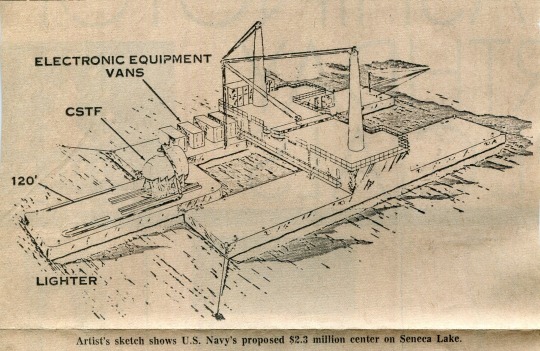
The next time you are driving along Seneca Lake, on State Route 414 along the eastern shore or – if you are traveling through Yates County – State Route 14 along the western shore, gaze into the middle of the lake and see if you find an interesting-looking platform floating on the surface. It shouldn’t be too hard to find, but you might wonder just what you are looking at.
This platform is, in fact, a barge anchored in the middle of Seneca Lake off the shore at Dresden. Indeed, the operation is officially known as the Seneca Lake Sonar Test Facility under the auspices of the Naval Sea Systems Command and the Naval Undersea Warfare Center of Newport, Rhode Island. Though it appears only civilian employees work there and no military personnel are stationed there, one could say this facility represents the only presence of the U.S. Navy existing in the Finger Lakes.
According to its website, the Seneca Lake Sonar Test Facility does just that – performing tests and evaluations of equipment to include sonar arrays and systems – and is known for its massive lift and power capabilities. Acoustic testing professionals carry out tests on systems and equipment of all sizes, even an entire sonar suite mounted in its sonar compartment.
Because it is a deep freshwater lake that is open all year, Seneca Lake is the Navy’s primary site for active instrumented calibration and testing. The fairly constant and predictable weather and water conditions of Seneca Lake also make it a choice testing site. It is known for its testing and evaluation of major projects that require relatively deep water with fixed underwater geometry and capabilities for heavy load-handling and electrical power.
Located about a mile and a half from the Dresden shore, the facility consists of two barges – the Systems Measurement Platform and the Remote Calibration Platform – that are the primary measurement and calibration resources. Two equipment-handling barges and numerous transport boats serve the facility, and there are machining and fabrication capabilities on the site to repair or manufacture the equipment and gear being tested.
The facility has been used by the Department of Defense, Department of the Navy, universities, foreign governments, state and local agencies, and private industry. And it has been a part of the Dresden landscape and lakeshore for more than 60 years.
It all began in November 1961, when the original barge – a converted oil tanker measuring 165 feet long and 36 feet long – arrived in Seneca Lake from Miami, via the inland waterway, Hudson River, and Barge Canal. During the heyday of the Cold War, as America furthered its research and development of anti-submarine warfare, the barge was purposed to test advanced sonar equipment designed to detect underwater craft. The barge was a key unit in establishing an anti-submarine acoustics research facility, headed by General Dynamics/Electronics.
The company leased a site at Dresden that provided 180 feet of lakefront – with construction of docking and service facilities to begin soon, according to an October 1961 newspaper article – along with a county road serving the property that would allow access to the facility throughout the year. Seneca Lake was chosen because its 600-foot depth makes it one of the deepest lakes in the country and – with the exception of the Great Lakes – the deepest lake with direct access to the Atlantic Ocean. It also has temperature gradients similar to those in the Atlantic Ocean, meaning sonar tests could be correlated to ocean conditions. The waves on the lake aren’t high enough to interfere with barge operations, and since the lake rarely freezes tests can be conducted throughout the year.
The original barge was equipped with a diesel-driven, 200-kilowatt generator to supply electric power to its electronic equipment, a capacity that was later increased to 400 kilowatts. The barge’s hulls had several ballast tanks, with water pumped out of or into the tanks to raise or lower the height of the deck above water.
Initially, the barge was designed to test then-recently-developed transducers weighing as much as 35 tons. These transducers convert electrical energy into acoustic energy, sending sound signals through the water that bounce off an intended target with an echo that can be recorded and analyzed. For test operations, the barge was to be manned by three engineers working under the direction of a manager.
In 1965, the Navy began leasing the Dresden Marina – with 4.5 acres of land and 900 feet of lakefront – for $20,000 per year with an option to buy the marina for $125,000. As a result of this move, owners of boats and crafts docked at the marina were forced to remove them from the marina and find new facilities to store them. Those with mobile homes located on the hill above the docks also had to vacate the premises. Another result was the Navy expanding its research facilities on Seneca Lake through an investment of $500,000. The improvements included completely fencing in the installation since much of its research work dealing with sound and sonar equipment is classified.
An undated newspaper article – handwritten with “1967,” though the exact date is unclear – indicates the Navy bought the marina a couple of years later for $166,000 and took it over outright. That year, Albert Gatthardt, of the Washington Naval Research Center, spoke before a jointing meeting of the Seneca Falls and Waterloo Rotary Clubs and detailed the history of the Naval Research Laboratory and its recent developments and improvements.
Alternately known as the Seneca Underwater Test and Evaluation Center, the facility was profiled in a July 1968 newspaper article on the occasion of the barge’s conversion from diesel power generated aboard to being powered by an electrical cable from the shore. The change permitted the barge – referred to in the article as DARIUS, though it is unclear what that stands for – to test the largest underwater sonar sound sources.
The following year, the Navy announced a $2.2 million expansion of the research facility on Seneca Lake, making it “the newest, largest, and best underwater research center in the country.” Plans called for using the existing barges plus a new systems measurement platform measuring 195 feet long, 120 feet wide, and 9 and a half feet deep, with a crane capable of lifting 200 tons. The expansion would continue the Navy’s research into sound transmission, travel, and reception underwater, light transmission and reception, underwater radio communications, development of new oceanographic tools and techniques, and underwater tests in the field physics.
As of February 1969, the facility employed eight permanent employees – a number expanded by 10 or 20 visiting technicians, engineers, and scientists. With the expansion anticipated to finish in the summer of 1970, plans called for 15 permanent employees with a capacity for 40 people visiting and working on the site.
By September 1970, work on the expansion had fallen behind but was mostly complete, and the facility continued testing equipment on Seneca Lake. More than 50 years later, the Navy still has a presence in the Finger Lakes, and it is one you can see from the road or the shore.

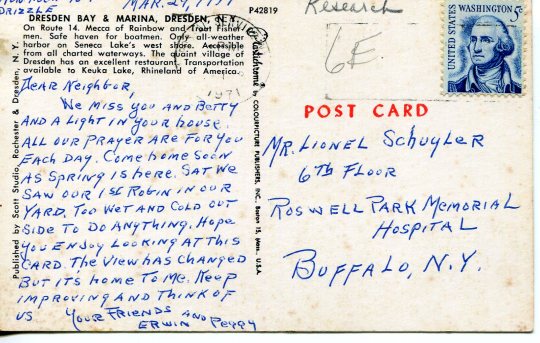
#history#historyblog#local history#american history#us history#yatescounty#newyork#dresdenny#navy#usnavy
2 notes
·
View notes
Text
Aluminum door

An aluminum door is a durable, lightweight, and versatile option for residential, commercial, and industrial spaces. Known for its sleek design, corrosion resistance, and structural strength, aluminum doors are available in various styles, sizes, and finishes to suit different needs and architectural aesthetics.
Key Features of Aluminum Doors
Durability:
Resistant to rust and corrosion, making it ideal for outdoor use.
Withstands harsh weather conditions and heavy use.
Lightweight:
Easier to handle and install compared to heavier materials like steel or wood.
Aesthetic Appeal:
Offers a modern, sleek look.
Available in various finishes, including anodized, powder-coated, or natural metallic.
Customizability:
Can be manufactured to fit specific dimensions, designs, and color schemes.
Low Maintenance:
Requires minimal upkeep to maintain appearance and functionality.
Types of Aluminum Doors
Swing Doors:
Description: Traditional hinged doors that swing inward, outward, or both.
Applications: Main entrances, office doors, or interior partitions.
Sliding Doors:
Description: Panels slide horizontally along tracks.
Applications: Balconies, patios, or space-saving solutions.
Folding or Bi-Fold Doors:
Description: Panels fold accordion-style to open fully.
Applications: Large openings, such as in commercial spaces or open-plan designs.
Pivot Doors:
Description: Doors that pivot on a central or offset hinge.
Applications: Modern residential or commercial spaces.
Casement Doors:
Description: Hinged on the side and opens like a window.
Applications: Unique entryways or connecting interior spaces.
Glazed Aluminum Doors:
Description: Aluminum frames with glass panels.
Applications: Entrances requiring light and visibility.
Automatic Sliding or Swing Doors:
Description: Operated via sensors or switches for hands-free access.
Applications: High-traffic areas like malls, hospitals, or airports.
Advantages
Longevity:
Aluminum is resistant to wear, ensuring long service life.
Eco-Friendly:
Fully recyclable material with a lower carbon footprint.
Energy Efficiency:
Can be combined with thermal breaks and insulated glass for better energy performance.
Security:
Strong and resistant to break-ins when paired with robust locking systems.
Design Flexibility:
Suitable for various architectural styles, from classic to contemporary.
Finishes
Anodized:
Enhances corrosion resistance and provides a metallic finish.
Powder-Coated:
Available in a wide range of colors for a smooth and durable finish.
Wood-Grain Effect:
Combines the warmth of wood with the durability of aluminum.
Brushed or Polished:
Adds texture or shine for a sophisticated look.
Applications
Residential:
Entry doors, patio doors, and interior partitions.
Commercial:
Shopfronts, office doors, and high-traffic entrances.
Industrial:
Warehouse entrances, loading docks, and durable partitions.
Considerations
Thermal Performance:
Use insulated frames or thermal breaks for energy efficiency in extreme climates.
Glazing:
Combine with double or triple glazing for noise reduction and temperature control.
Hardware:
Invest in high-quality locks, handles, and hinges for better functionality and security.
Budget:
Aluminum doors are cost-effective but can vary based on design and customization.
0 notes
Text
Dock Shelter
Dock Technik offer UK stocked loading bay Dock Shelters. Our range includes Retractable Dock Shelters, Inflatable Dock Shelters, Dock Cushion Seals, Dock Shelter Repairs, Dock Shelter Service, Dock Shelter Sales, Dock Shelter Design and Dock Shelter Installation
Dock Shelter
Visit us :- https://www.docktechnik.com/dockshelters
0 notes
Text
Chicago Warehouse Space for Lease- Find the Perfect Fit for Your Business
Chicago, a hub for commerce and logistics in the United States, offers a dynamic and diverse market for businesses seeking warehouse space. Whether you're in retail, manufacturing, e-commerce, or distribution, leasing a warehouse in Chicago can provide a strategic advantage. With its central location, robust transportation network, and growing business community, the city is a top choice for companies looking to expand or streamline their operations. Here's what you need to know about finding the ideal Chicago warehouse space for lease.
Why Choose Chicago for Your Warehouse Needs?
1. Strategic Location: Situated in the heart of the Midwest, Chicago serves as a vital logistics hub, offering easy access to major cities across the country. Its proximity to highways, railways, and airports ensures smooth movement of goods, making it ideal for businesses reliant on efficient transportation.
2. Thriving Business Ecosystem: Chicago is home to a wide range of industries, from manufacturing to technology and e-commerce. This diverse business environment fosters opportunities for partnerships, collaborations, and market expansion.
3. Robust Infrastructure: The city boasts world-class infrastructure, including access to O'Hare International Airport, one of the busiest cargo airports in the world, and the Port of Chicago, which connects businesses to international markets.
Types of Warehouse Spaces Available
Chicago offers a variety of warehouse options to suit different business needs:
Distribution Centers: Designed for businesses focused on logistics and supply chain operations. These spaces are equipped with features like high ceilings, dock doors, and proximity to transportation hubs.
Cold Storage Facilities: Ideal for companies in the food and pharmaceutical industries requiring temperature-controlled environments.
Light Industrial Spaces: Suitable for manufacturing or assembly operations, often with office space included.
Flex Spaces: A combination of warehouse and office space, perfect for startups and small businesses.
Key Considerations When Leasing a Warehouse
1. Location: Proximity to your customers, suppliers, and transportation routes is critical. Chicago's neighborhoods, such as the West Loop, South Side, and suburbs like Elk Grove Village, each offer unique advantages.
2. Space Requirements: Evaluate your operational needs, including square footage, storage capacity, and special features like loading docks or climate control.
3. Lease Terms: Understand the lease terms, including duration, rental costs, maintenance responsibilities, and any additional fees. Negotiate terms that align with your business goals.
4. Accessibility: Ensure the warehouse is accessible to trucks and delivery vehicles, with ample parking and loading areas.
5. Future Growth: Plan for scalability. Choose a space that can accommodate your business’s growth without requiring frequent relocations.
Popular Chicago Locations for Warehouses
1. Near Downtown Chicago: Convenient for businesses needing proximity to the city center. Ideal for last-mile delivery services and retail operations.
2. Industrial Corridors: Neighborhoods like the West Side and South Side feature established industrial zones with ample warehouse options.
3. Suburban Markets: Areas like Elk Grove Village and Schaumburg offer larger warehouse spaces with lower costs compared to downtown. These locations are perfect for large-scale distribution centers.
Final Thoughts
Leasing a warehouse space in Chicago can be a transformative decision for your business. With its central location, thriving economy, and flexible options, the city provides a fertile ground for growth and success. Work with a trusted real estate agent or commercial property specialist to navigate the market and secure the best deal.
By understanding your needs and thoroughly researching the available options, you can find a Chicago warehouse space for lease that perfectly aligns with your business objectives. Whether you're expanding operations or launching a new venture, Chicago's warehouse market is ready to support your vision.
0 notes
Text
The Role of Excavation in Jonesboro, AR for Snow and Ice Management Projects
Winter in Jonesboro, AR, brings its own set of challenges, especially when it comes to managing snow and ice on properties. For businesses and homeowners alike, ensuring safe and efficient access to driveways, parking lots, and walkways is essential. While snow removal is a common winter activity, excavation plays a critical role in improving long-term snow and ice management. Here’s how professional excavation in Jonesboro, AR can help property owners better prepare for and handle winter conditions.
1. Creating Designated Snow Storage Areas
One of the biggest challenges in winter is figuring out where to store accumulated snow after plowing or shoveling. Without a proper plan, snow piles can obstruct driveways, parking lots, or walkways, leading to safety concerns and restricted access.
Excavation services can:
Clear and Level Land: Create designated areas for piling snow safely, away from high-traffic zones.
Optimize Drainage: Ensure that meltwater from snow piles drains properly to avoid flooding or ice buildup.
Enhance Efficiency: Provide snow removal teams with pre-designated spaces, speeding up the clearing process.
These storage areas are particularly beneficial for commercial properties with large parking lots, where space is at a premium during winter.
2. Improving Driveway and Road Access
Icy or snow-covered access roads and driveways can be hazardous during winter. Excavation services can help by reshaping the landscape to ensure better usability and safety.
Key benefits include:
Grading and Slope Adjustment: Proper grading helps prevent water from pooling and freezing on roads and driveways, reducing the risk of accidents.
Widening Narrow Paths: Excavation can expand driveways or access roads to accommodate snowplows or provide more room for snow clearance.
Reinforcing Surfaces: Preparing and stabilizing the base of driveways before winter ensures they withstand freezing and thawing cycles without damage.
3. Enhancing Drainage Systems
Winter weather often leads to melting snow and ice, creating excess water that needs proper management. Without adequate drainage systems, this water can refreeze, forming hazardous ice patches.
Excavation can improve drainage by:
Installing or Updating Drainage Systems: Trenches or underground systems can direct meltwater away from critical areas.
Clearing Blocked Drains: Excavation teams can remove soil or debris that clogs drainage systems, ensuring smooth water flow.
Creating Swales and Retention Areas: These features help manage water runoff and prevent it from freezing in unwanted areas.
4. Preparing for De-Icing Systems
Many properties in Jonesboro are turning to advanced de-icing systems, such as heated driveways or sidewalks, to combat winter weather. Excavation is a vital part of installing these systems.
Excavation teams can:
Prepare the Ground: Excavate the area to lay electrical heating elements or hydronic pipes beneath surfaces.
Ensure Proper Installation: Create stable foundations for long-lasting de-icing systems.
Integrate with Existing Infrastructure: Work around current drainage or utility lines to ensure a seamless installation.
These systems not only improve safety but also reduce the need for constant manual snow removal.
5. Supporting Commercial Snow Management
Businesses in Jonesboro often face unique snow and ice management challenges, particularly in high-traffic areas like parking lots and loading docks. Excavation services can support commercial operations by:
Creating Snow-Free Zones: Clear and prepare areas for efficient plowing and storage.
Improving Access for Equipment: Ensure snowplows, loaders, and other machinery have adequate space to operate.
Minimizing Downtime: Address potential drainage or access issues before winter hits, ensuring uninterrupted operations.
6. Preparing for the Winter-to-Spring Transition
While the focus during winter is on managing snow and ice, the thaw that follows can create new challenges. Excavation during winter can help properties prepare for this transition by:
Preventing Erosion: Stabilizing soil and grading land to reduce the risk of erosion from melting snow.
Repairing Damage: Fixing areas prone to frost heave or other winter-related issues.
Setting Up Spring Projects: Early excavation work can lay the groundwork for landscaping or construction projects once warmer weather arrives.
Why Choose Professional Excavation Services in Jonesboro, AR?
Winter excavation requires specialized equipment, expertise, and planning to account for frozen ground, weather conditions, and safety concerns. Partnering with an experienced team ensures:
Compliance with local regulations.
Minimal disruption to your property.
Effective solutions tailored to your specific needs.
At Dark Horse Drilling, we provide reliable and efficient excavation services in Jonesboro, AR, to help you manage winter challenges with ease. From creating snow storage areas to improving drainage and access, we have the tools and expertise to keep your property safe and functional all season long.
Conclusion
Excavation plays an essential role in addressing snow and ice management challenges for properties in Jonesboro, AR. Whether it’s preparing designated snow storage areas, improving drainage, or setting up de-icing systems, professional excavation services can make your property safer and more efficient during winter.
If you’re ready to improve your property’s winter readiness, contact Dark Horse Drilling today. Our team specializes in customized excavation solutions to meet the unique needs of Jonesboro residents and businesses. Visit Dark Horse Drilling to learn more or request a consultation!
0 notes
Text
Safe, Efficient And Hygienic Loading With A Stepped Dock - Loading Systems

Efficient and safe goods handling is an important aspect of any logistics company. Loading and unloading requires a smooth transition between the dock and the truck. This is necessary to move the cargo safely without any risk of injury or damage to equipment.
Traditional dock leveller versus stepped dock leveller
Traditional dock levellers often have a flat plate. This plate can move up and down to bridge the height difference between the dock and the truck. This design works well for trucks with a consistent height. But it can be problematic if different types of trucks and trailers are used. This is where the stepped dock leveller can provide a solution.
A stepped dock leveller consists of a series of raised platforms, also known as steps. These steps can be aligned with the floor of the truck. This creates a safe and stable loading zone. This allows the truck to dock with the doors closed. No unnecessary manoeuvres are required to raise the vehicle to the correct height. Once the truck is correctly positioned, the doors can be opened and loading and unloading can begin.
Advantages of the stepped dock leveller
One of the advantages of the stepped dock leveller is that it improves worker safety. Because the truck can dock with the doors closed, there is less risk of accidents. Time is also saved as the truck does not have to be raised to the correct height first. This reduces the risk of delays and ensures a faster flow of goods.
Another advantage of the stepped dock leveller is that it improves hygiene when transporting chilled or frozen goods. The closed doors ensure that the temperature inside the truck is maintained and that no external contaminants can enter, ensuring the quality and safety of the goods.
A stepped dock leveller is also ideal for customs purposes. When the doors of the truck need to remain closed until customs officials arrive, the truck can be docked and the doors kept closed. This not only prevents unauthorised access to the cargo, but also ensures that customs officials can do their work quickly and efficiently without unnecessary delays.
An additional benefit of a stepped dock leveller is that it helps prevent theft and break-ins. By keeping the doors closed during loading and unloading, it becomes more difficult for thieves to gain unseen access to the cargo.
Loading Systems' stepped dock can be configured to your specific needs
Are you interested in optimising your loading bay by means of a stepped dock leveller or other loading solutions? Loading Systems offers a wide range of products and services to meet all your requirements. Contact us today for more information and a no-obligation quotation!
0 notes
Text
How to Choose the Right Dock Management System for Your Operations

Efficient logistics and supply chain operations are critical for businesses aiming to meet customer expectations and reduce operational costs. A dock management system plays a pivotal role in achieving these goals by streamlining dock scheduling, load management, and communication between teams. Choosing the right Dock Management System for your operations requires careful consideration of features, scalability, and overall compatibility with your business needs. This guide will help you navigate the process.
What is a Dock Management System?
A dock management system is a software solution designed to optimize and manage loading and unloading activities at warehouse docks. It helps coordinate schedules, reduce bottlenecks, and improve resource utilization by automating manual processes. The system ensures seamless communication between dock personnel, transporters, and warehouse staff, making it an essential tool for modern logistics operations.
Benefits of Implementing a Dock Management System
Before diving into how to choose the right system, it’s important to understand its benefits:
Enhanced Efficiency: Automates dock scheduling and reduces idle time.
Cost Reduction: Optimizes resource allocation, cutting down on labor and overhead costs.
Improved Visibility: Provides real-time updates on dock activities and shipment status.
Better Customer Service: Ensures on-time deliveries by reducing delays.
Minimized Errors: Reduces the chances of scheduling conflicts and manual mistakes.
Steps to Choose the Right Dock Management System
1. Assess Your Operational Needs
Begin by identifying the specific challenges your operations face. These could include scheduling inefficiencies, lack of real-time updates, or frequent errors in load management. Define your requirements and prioritize the features that align with your business goals.
Key Questions to Ask:
Do we need real-time tracking and updates?
How many docks and shipments do we manage daily?
Are integration capabilities with existing systems a priority?
2. Look for Core Features
A reliable dock management system should include several essential features. Ensure the system you choose offers the following functionalities:
Scheduling Automation: Streamlined scheduling to avoid conflicts.
Real-Time Tracking: Visibility into dock activities and truck movements.
Analytics and Reporting: Insights into performance metrics to identify areas of improvement.
Integration Options: Compatibility with existing warehouse management or ERP systems.
User-Friendly Interface: Easy-to-navigate dashboards for all team members.
3. Scalability and Flexibility
Choose a system that can grow with your business. If you plan to expand your operations or handle more shipments in the future, ensure the dock management system is scalable and can accommodate increased demand. Flexibility in customization is also crucial, as every business has unique operational workflows.
4. Cloud-Based vs. On-Premises Solutions
Decide whether a cloud-based or on-premises dock management system suits your needs.
Cloud-Based Systems: Offer accessibility from anywhere, lower upfront costs, and automatic updates.
On-Premises Systems: Provide greater control over data and security but require significant infrastructure investment.
Your choice will depend on your budget, IT capabilities, and operational preferences.
5. Integration Capabilities
The dock management system should seamlessly integrate with other software systems, such as warehouse management systems (WMS), transportation management systems (TMS), and enterprise resource planning (ERP) tools. Integration ensures a smooth flow of data across departments, improving overall efficiency.
6. Evaluate Vendor Support
A robust dock management system requires strong vendor support for implementation, training, and troubleshooting. Ensure the provider offers reliable customer support, regular updates, and comprehensive training for your team.
7. Test the System
Request a demo or trial version of the system before committing. This allows you to evaluate its functionality, ease of use, and compatibility with your operations. Gather feedback from your team to ensure the system meets their needs.
8. Consider the Cost
While cost is an important factor, it shouldn’t be the sole deciding factor. Compare pricing models, such as subscription-based or one-time payment options, and consider the value the system will bring to your operations.
Common Mistakes to Avoid
Neglecting Employee Input: Your team will be the primary users of the system. Failing to involve them in the decision-making process can lead to poor adoption.
Overlooking Integration Needs: Ensure the system can integrate with your existing tools to avoid operational silos.
Choosing Based Solely on Cost: Opting for the cheapest option may result in a system that lacks essential features or scalability.
Conclusion
Choosing the right dock management system is a critical step in enhancing your logistics and supply chain operations. By assessing your needs, prioritizing core features, and evaluating scalability and integration capabilities, you can make an informed decision that aligns with your business objectives. Investing in a reliable dock management system will not only improve efficiency and reduce costs but also position your business for long-term success in a competitive market.
0 notes
Text
Finding the Perfect Weighing Solutions in the Pacific Northwest
Why Truck Scales Are Essential in Oregon
Truck scales play an integral role in industries that handle large quantities of goods. They’re commonly found at shipping docks, construction sites, and recycling centers, where weighing heavy vehicles and their cargo is necessary to prevent overloading and ensure safety. In Oregon, the demand for durable and precise truck scales has risen due to the state's robust agricultural and logistics sectors.
When considering Truck scale sales Oregon, businesses should evaluate factors such as capacity, durability, and ease of maintenance. The dynamic weather conditions in Oregon can also influence the type of truck scale you choose, making it essential to invest in corrosion-resistant materials and advanced calibration features. Portable truck scales are becoming increasingly popular in the region due to their flexibility and ease of relocation, especially for businesses operating across multiple sites.
Choosing the Right Pallet Scales in Washington
Washington is home to a bustling warehousing and manufacturing industry, making pallet scales indispensable for efficient operations. These scales are designed to weigh pallets loaded with goods, ensuring accurate measurements and reducing errors in inventory management. Whether you're running a small business or a large-scale operation, investing in the right pallet scale can streamline processes and improve productivity.
When exploring Pallet scale sales Washington, it's important to consider scales with user-friendly interfaces and robust designs. Modern pallet scales often come with wireless connectivity, enabling seamless integration with inventory management systems. Additionally, businesses in Washington should look for scales that meet their specific weight range and load capacities to avoid underperformance or overloading issues. Stainless steel options are particularly advantageous for environments prone to moisture or chemical exposure.
Key Features to Look for in Weighing Systems
Whether you're purchasing a truck scale in Oregon or a pallet scale in Washington, certain features can significantly enhance the efficiency and lifespan of your investment. One of the most important factors is accuracy. High-precision load cells and advanced calibration technology ensure that your scales deliver consistent results, even in demanding environments.
Durability is another crucial consideration. Scales made from high-quality materials can withstand heavy use, harsh weather conditions, and potential wear and tear. Maintenance and servicing options should also be taken into account, as regular upkeep can extend the life of your equipment and minimize downtime.
Finally, look for scalability and adaptability. The ability to upgrade or modify your weighing system as your business grows ensures a future-proof investment. In regions like Oregon and Washington, where industries often evolve rapidly, having versatile solutions is key.
Benefits of Partnering with Local Suppliers
One of the biggest advantages of purchasing weighing systems locally is access to tailored solutions. Suppliers specializing in Truck scale sales Oregon and Pallet scale sales Washington often have a deep understanding of the regional industry requirements and environmental conditions. They can recommend scales that are best suited to your specific needs, ensuring optimal performance and reliability.
Local suppliers also provide faster installation, repair, and calibration services, minimizing downtime and disruptions to your operations. Additionally, supporting regional businesses helps foster economic growth within the community, creating a win-win scenario for everyone involved.
Investing in the Future with Advanced Technology
The weighing industry has seen significant advancements in recent years, with modern systems incorporating smart features to enhance functionality. From digital displays and automated reporting to wireless connectivity and cloud-based integration, these innovations are transforming how businesses handle weighing tasks. Companies in Oregon and Washington can benefit greatly by choosing scales equipped with such advanced features.
For example, truck scales with remote monitoring capabilities allow managers to oversee operations in real time, even from a distance. Similarly, pallet scales with built-in data tracking can streamline inventory audits and reduce manual labor. By investing in cutting-edge technology, businesses can stay ahead of the competition and achieve greater operational efficiency.
0 notes
Text
Dock Leveller
DockTechnik offer a range of loading bay Dock Levellers. Our range includes Swing Lip Dock Levellers, Telescopic Lip Dock Levellers, Dock Leveller Repairs, Dock Leveller Service, Dock Leveller Sales and Design.
Dock Leveller
Visit us :- https://www.docktechnik.com/docklevellers
0 notes
Text
Innovative Goods Lifts from Marck Industries: Elevating Your Material Handling Solutions
Introduction: In today’s fast-paced industrial environments, efficient vertical transportation of goods is crucial. Whether you are in retail, warehousing, or manufacturing, having reliable and durable goods lifts is an absolute necessity. Marck Industries, a leading manufacturer, offers innovative and customized goods lift solutions designed to meet the diverse needs of businesses worldwide.
What is a Goods Lift? A goods lift is an essential piece of equipment used to transport goods and materials vertically between different floors of a building. Unlike elevators designed for passengers, goods lifts are specifically engineered for heavy-duty applications, such as transporting bulk items, machinery, or goods on trolleys. These lifts are designed to streamline operations, enhance efficiency, and reduce the manual effort involved in moving goods.
Why Choose Marck Industries for Your Goods Lift Solutions?
Customization and Versatility: At Marck Industries, we understand that no two businesses are alike. Our goods lifts come in various sizes and configurations to cater to the specific needs of different industries. From light-duty goods lifts to heavy-duty versions capable of carrying loads up to several tons, we offer tailored solutions for every application.
Durability and Reliability: Our lifts are built using high-quality materials and cutting-edge technology to ensure longevity and smooth performance even under heavy loads. With rigorous testing and quality control, you can trust that our products will stand the test of time and offer maximum reliability.
Safety Features: Safety is paramount in industrial environments. Our goods lifts are equipped with multiple safety features such as overload protection, emergency stop buttons, and safety barriers. Additionally, our lifts meet all local and international safety standards to ensure a secure operation for both the workers and the products.
Energy Efficiency: As a responsible manufacturer, Marck Industries emphasizes sustainability. Our goods lifts are engineered to be energy-efficient, reducing operational costs and contributing to a greener environment. This energy-saving design ensures that businesses benefit from lower electricity consumption while maintaining optimal performance.
Expert Installation and Maintenance Services: Our services go beyond manufacturing. Marck Industries provides expert installation, ensuring that your goods lift is set up efficiently and to the highest standards. Additionally, we offer comprehensive after-sales support, including maintenance services, to keep your lift running smoothly for years to come.
Types of Goods Lifts Offered by Marck Industries:
Freight Lifts: Perfect for transporting goods between different levels in commercial buildings, warehouses, and factories. These are capable of carrying larger, bulkier items and can be customized to fit different load capacities and dimensions.
Scissor Lifts: Our scissor lifts are ideal for areas with limited space and are perfect for handling both light and heavy goods. They offer smooth vertical movement and are a popular choice for loading docks and storage areas.
Hydraulic Lifts: For applications that require smooth, reliable, and heavy-duty lifting, our hydraulic goods lifts deliver high performance and stability. These are commonly used in industries such as automotive, retail, and manufacturing.
Platform Lifts: A cost-effective solution for smaller businesses needing a lift for light goods. These compact lifts are easy to install and offer excellent efficiency for everyday operations.
Conclusion: Marck Industries is a trusted name in the manufacturing of high-quality goods lifts. With our focus on reliability, safety, and customization, we offer businesses solutions that enhance operational efficiency and productivity. If you are looking for a durable, cost-effective, and versatile goods lift, Marck Industries is your go-to partner.
Contact us today to discuss your requirements and explore our wide range of goods lift solutions.
0 notes